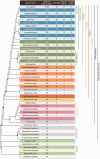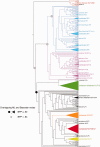KLF/SP Transcription Factor Family Evolution: Expansion, Diversification, and Innovation in Eukaryotes
- PMID: 26232396
- PMCID: PMC4558859
- DOI: 10.1093/gbe/evv141
KLF/SP Transcription Factor Family Evolution: Expansion, Diversification, and Innovation in Eukaryotes
Abstract
The Krüppel-like factor and specificity protein (KLF/SP) genes play key roles in critical biological processes including stem cell maintenance, cell proliferation, embryonic development, tissue differentiation, and metabolism and their dysregulation has been implicated in a number of human diseases and cancers. Although many KLF/SP genes have been characterized in a handful of bilaterian lineages, little is known about the KLF/SP gene family in nonbilaterians and virtually nothing is known outside the metazoans. Here, we analyze and discuss the origins and evolutionary history of the KLF/SP transcription factor family and associated transactivation/repression domains. We have identified and characterized the complete KLF/SP gene complement from the genomes of 48 species spanning the Eukarya. We have also examined the phylogenetic distribution of transactivation/repression domains associated with this gene family. We report that the origin of the KLF/SP gene family predates the divergence of the Metazoa. Furthermore, the expansion of the KLF/SP gene family is paralleled by diversification of transactivation domains via both acquisitions of pre-existing ancient domains as well as by the appearance of novel domains exclusive to this gene family and is strongly associated with the expansion of cell type complexity.
Keywords: C2H2 zinc fingers; domain architecture; domain co-occurrence network; domain evolution; domain shuffling; low-complexity regions.
© The Author(s) 2015. Published by Oxford University Press on behalf of the Society for Molecular Biology and Evolution.
Figures






References
-
- Abascal F, Zardoya R, Posada D. 2005. Prottest: selection of best-fit models of protein evolution. Bioinformatics 21:2104–2105. - PubMed
-
- Adams MD, et al. 2000. The genome sequence of Drosophila melanogaster. Science 287:2185–2195. - PubMed
-
- Aparicio S, et al. 2002. Whole-genome shotgun assembly and analysis of the genome of Fugu rubripes. Science 297:1301–1310. - PubMed
Publication types
MeSH terms
Substances
Associated data
- Actions
- Actions
Grants and funding
LinkOut - more resources
Full Text Sources
Other Literature Sources

